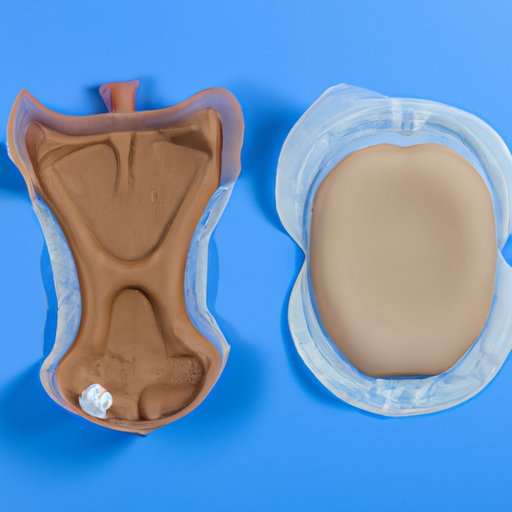Introduction
An ostomy bag (or colostomy bag) is a medical device used to collect waste from the body in people who have had surgery on their digestive system. The ostomy bag is typically attached to the abdomen and collects waste from the stoma, which is an opening created during surgery.
The purpose of this article is to provide a comprehensive guide to what an ostomy bag is and how it works, as well as tips for managing an ostomy and understanding the benefits of having an ostomy bag.
A Comprehensive Guide to What an Ostomy Bag Is and How It Works
An ostomy bag is made up of several parts that work together to collect waste and keep the skin dry and healthy. Here is an overview of the anatomy of an ostomy bag:
- Stoma: This is the opening where the waste exits the body.
- Flange: This is a ring-shaped piece that adheres to the skin around the stoma.
- Bag: This is the part of the ostomy bag that collects the waste.
- Filter: This is a small filter that helps reduce odors.
- Closure: This is the part of the bag that seals it so that it does not leak.
There are several different types of ostomy bags available, including one-piece systems, two-piece systems, and urostomy bags. Each type of ostomy bag has its own advantages and disadvantages.
Changing an ostomy bag is usually done every 1-3 days, depending on the type of ostomy bag and the amount of waste produced. It’s important to follow the instructions provided by the manufacturer when changing an ostomy bag to ensure proper hygiene and avoid any potential complications.
Living with an Ostomy Bag: Tips for Managing Your Ostomy
Living with an ostomy bag can be challenging, but there are some things you can do to make it easier. Here are some tips for managing your ostomy:
- Diet and Nutrition: Eating a balanced diet of fresh fruits and vegetables, whole grains, lean proteins, and healthy fats can help manage your ostomy and keep your digestive system functioning properly.
- Emotional Well-Being: Living with an ostomy can be emotionally challenging, so it’s important to take time for yourself and find ways to cope with stress. Talking to a therapist or joining a support group can be helpful.
- Exercise: Regular exercise can help improve your overall health and well-being, which can make living with an ostomy easier.

Exploring the Different Types of Ostomy Bags
The type of ostomy bag you use will depend on your individual needs, so it’s important to talk to your doctor about the different types of ostomy bags available. Here is an overview of the three main types of ostomy bags.
One-Piece System
The one-piece system is the most common type of ostomy bag. It consists of a single unit that includes the flange, bag, and closure. This type of ostomy bag is easy to use and requires less maintenance than other types of ostomy bags.
Two-Piece System
The two-piece system consists of two separate pieces: the flange and the bag. This type of ostomy bag is more customizable than the one-piece system and offers more flexibility in terms of size and shape.
Urostomy Bags
Urostomy bags are designed specifically for people with urinary incontinence or bladder problems. They are similar to ostomy bags, but they are designed to collect urine rather than waste from the digestive system.

Myths vs Facts About Ostomy Bags
There are many myths and misconceptions about ostomy bags, so it’s important to understand the facts. Here are some common myths and the truth behind them:
- Myth: Ostomy bags are uncomfortable and cause pain.
Fact: With proper fitting and care, ostomy bags can be comfortable and even unnoticeable. - Myth: Ostomy bags are embarrassing.
Fact: Ostomy bags can be concealed under clothing, making them virtually invisible to others. - Myth: Ostomy bags smell bad.
Fact: Modern ostomy bags are designed to reduce odor and are much less noticeable than in the past.
In addition to dispelling common myths, it’s also important to understand the benefits of having an ostomy bag. Having an ostomy bag can improve quality of life, reduce the risk of complications, and save money in the long run.

Understanding the Benefits of an Ostomy Bag for People with Digestive Conditions
Having an ostomy bag can have many benefits for people with digestive conditions. Here are some of the main benefits of having an ostomy bag:
- Improved Quality of Life: An ostomy bag can improve quality of life by reducing pain, increasing mobility, and improving nutrition.
- Reduced Risk of Complications: Having an ostomy bag can reduce the risk of complications associated with digestive conditions, such as infections, dehydration, and malnutrition.
- Cost Savings: An ostomy bag can save money in the long run by reducing hospitalization costs and eliminating the need for costly medications.
Conclusion
An ostomy bag is a medical device used to collect waste from the body in people who have had surgery on their digestive system. There are several different types of ostomy bags available, and each type has its own advantages and disadvantages. It’s important to understand the facts about ostomy bags and the benefits of having one, as well as tips for managing your ostomy. By following these tips and talking to your doctor about the different types of ostomy bags available, you can find the right one for you and live a healthier, happier life.


